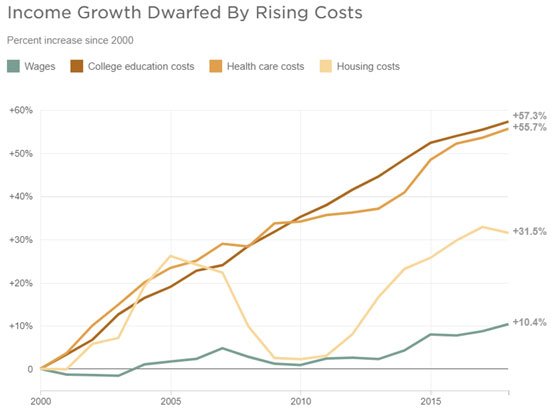(Note: This article is dedicated to the memory of Carl Watner, who died on December 8, 2020 at the age of 72. A long-time defender of individual liberty and free markets, his 1976 article in Reason magazine, “California Gold, 1849-65,” helped renew awareness and appreciation for private money in American history). Put the federal government in charge of the supply of money, let it outlaw private competition and bestow a “legal tender” privilege on its own paper and coin, and its wise officials will know exactly how much money the marketplace needs. If you believe that rubbish, I have a bridge over the river Kwai I would like to sell you. In just the 106 years of the Federal Reserve, America’s money supply has bounced wildly up and down (mostly up), prompting such
Topics:
Lawrence W. Reed considers the following as important: 6a) Gold & Bitcoin, 6a.) Gold Standard, Featured, newsletter
This could be interesting, too:
RIA Team writes The Importance of Emergency Funds in Retirement Planning
Nachrichten Ticker - www.finanzen.ch writes Gesetzesvorschlag in Arizona: Wird Bitcoin bald zur Staatsreserve?
Nachrichten Ticker - www.finanzen.ch writes So bewegen sich Bitcoin & Co. heute
Nachrichten Ticker - www.finanzen.ch writes Aktueller Marktbericht zu Bitcoin & Co.
(Note: This article is dedicated to the memory of Carl Watner, who died on December 8, 2020 at the age of 72. A long-time defender of individual liberty and free markets, his 1976 article in Reason magazine, “California Gold, 1849-65,” helped renew awareness and appreciation for private money in American history).
Put the federal government in charge of the supply of money, let it outlaw private competition and bestow a “legal tender” privilege on its own paper and coin, and its wise officials will know exactly how much money the marketplace needs.
If you believe that rubbish, I have a bridge over the river Kwai I would like to sell you.
In just the 106 years of the Federal Reserve, America’s money supply has bounced wildly up and down (mostly up), prompting such calamities as numerous recessions and one depression, unprecedented price and interest rate volatility, and a currency worth a fraction of its 1914 value.
In the 19th century, the federal government’s monetary performance wasn’t much better. Its two experiments in central banking ended in embarrassment; the economy ultimately fared better once they were gone. In the 1860s, the federal government failed to provide coinage of small denomination at the same time it depreciated the value of its paper “greenbacks” by more than half in only four years. For the entire century, it mismanaged the pricing of silver in terms of gold, driving one metal out of circulation for a while and then driving out the other one.
What is it that makes people believe that politicians and their friends will manage money better than supply and demand in free, competitive markets? Does anyone in his right mind think that if we turned beans over to the government, we would always have just the right kinds in precisely the right amounts?
That’s the stuff of fairy tales. Governments are to money what witch doctors are to medical care.
But I digress. My primary reason for writing this article is to share with readers a small but fascinating bit of monetary history. It is a story commemorated by a historical marker in Gainesville, Georgia that reads as follows:
First Private Mint: Templeton Reid Mint
1830-1831
Two hundred yards west, on the north side of Washington St., is the site of the first private mint in the United States to manufacture gold coins in dollar values. During the Georgia gold rush, trade suffered due to a shortage of sound money. There were few coins in circulation and most business was by barter.
Templeton Reid (ca. 1787-1851), Milledgeville silversmith and expert machinist, saw an answer to the problem. He decided to buy raw gold, refine it, and stamp coins of proven value, acceptable in any transaction. In 1830 he came to Gainesville, Georgia and opened an assay office. With machines and dies of his design and make he began to strike coins of $2.50, $5.00, and $10.00 denominations. Although questioned by many, this was legal under the U.S. Constitution. The business was not profitable and closed in 1831. The Reid gold coins minted in Gainesville are extremely rare and are eagerly sought by collectors.
There’s a lot more to the story than you can fit on a sign, and it speaks favorably about markets, entrepreneurship, and competitive choices in money.
The 1829 gold rush in the north Georgia mountains was the biggest in America before the fabled discovery of the yellow metal in California 20 years later. At the time, though the official policy of the US government was bimetallism (both gold and silver coin in circulation), the practical effect of Washington’s price-fixing was to put the country on a de facto silver standard. Gold was obviously in demand, but the government minted very little. The Southern Gold Society states, “Some estimates indicate that there was less than one federally minted coin per person in the United States.”
So, as the sign says, Templeton Reid was the first to fill the void by opening his own mint. Where there’s a demand, some enterprising man or woman will rush to provide a supply if given the freedom to do so. In The Georgia Gold Rush: Twenty-Niners, Cherokees and Gold Fever, author David Williams says, “This was exactly what the miners needed—a place to exchange their gold for coin at a not too distant location.”
Previously, miners had to take their gold to the government’s mint in Philadelphia. Not until 1835 did the Congress see the value of opening mints in the gold regions of North Carolina (in Charlotte) and Georgia (in Dahlonega). (Good thing Americans in the South didn’t have to go all the way to Philadelphia to get their beans). Reid’s coins were stamped “Georgia Gold 1830” on one side and “Templeton Reid, Assayer” and the denomination on the other.
Now what about the Reid mint’s short life? The sign says it opened in 1830 and closed in 1831. There’s a story and a lesson to that as well.
Templeton Reid had good intentions but lacked the sophistication to get the proper fineness of gold into each coin he minted. What he stamped as a $10 gold piece, for instance, turned out to be fractionally less pure gold than the coin’s denomination indicated—as the dollar was then defined and as gold was then worth in the marketplace. You might assume Reid was dishonest, but the consensus of historians seems to be that it was imprecision, not fraud, that caused the problem. Williams writes,
As it turned out, Reid’s coins were indeed worth less than face value. It seems Reid failed to take into account the impurities such as silver and tin alloyed with gold in its natural state. An 1835 article in The American Journal of Science and Arts reported than an analysis of a Reid ten-dollar gold piece revealed a purity of 95.579 percent, the remainder being silver. But Reid had assumed the purity of raw gold to be at least 99 percent and stamped his coins accordingly. Though apparently Reid was, in the words of one writer, “more ignorant than greedy,” it was a mistake that proved fatal to his business.
Who blew the whistle? Was it some level of government—federal, state or local? Nope. It was a letter-to-the-editor writer who signed his letters “No Assayer.” Reid’s mint was barely up and running when, in August 1830, the Southern Recorder ran a letter from “No Assayer.” It contended that the gold in Reid’s coins was fine, but not quite fine enough.
In another letter days later, “No Assayer” strongly inferred that Reid was knowingly gouging the public. It was enough to scare people into avoiding the mint. Reid never recovered and never made a dime before he had to shut down. Markets can be merciless in punishing mistakes no matter the mistake-maker’s intentions. But a government central bank can screw up royally, time after time for a century or more, and it just goes on and on.
Templeton Reid’s operation was the first private gold-coin mint in America but others quickly followed. One of the more notable ones, for example, was that of the Bechtler family in North Carolina. It operated from 1831 to 1849.
Entrepreneurs come up with far more challenging, even outlandish, projects than supplying the marketplace with a medium of exchange. They gave us iPhones and airplanes, and a billion more things previously inconceivable. That’s why the notion that only government can “make money” is not only historically inaccurate, it’s also downright silly.
For additional information, see:
California Gold, 1849-65 by Carl Watner
Why You Can’t Mint a Dime by Lawrence W. Reed
The Neighborhood Mint by Sylvia Gailey Head and Elizabeth W. Etheridge
The Georgia Gold Rush: Twenty-Niners, Cherokees and Gold Fever by David Williams
Dahlonega: A Brief History by Anne Dismukes Amerson
Templeton Reid by The Southern Gold Society
The Silver Panic by Lawrence W. Reed
The Forgotten Private Banker by Richard Sylla
Denationalization of Money by F. A. Hayek
This article originally appeared here. Image credit: Pixabay
Tags: Featured,newsletter








